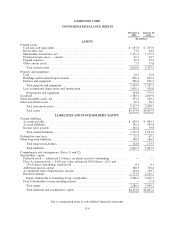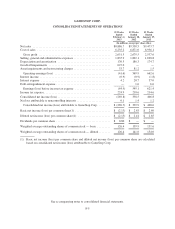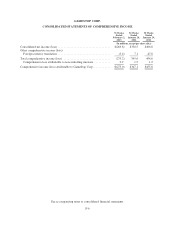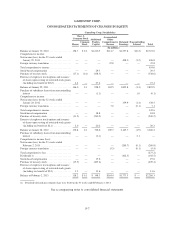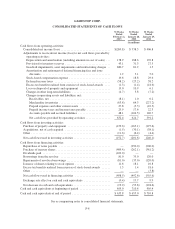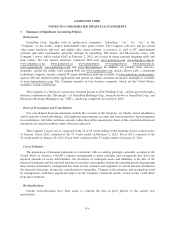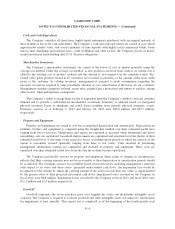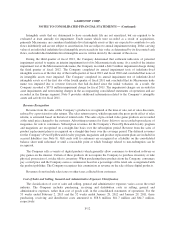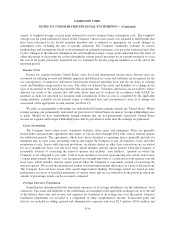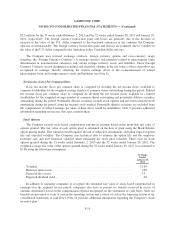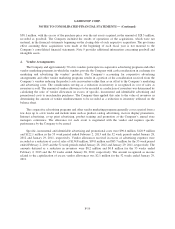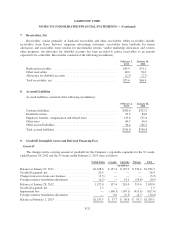GameStop 2012 Annual Report Download - page 88
Download and view the complete annual report
Please find page 88 of the 2012 GameStop annual report below. You can navigate through the pages in the report by either clicking on the pages listed below, or by using the keyword search tool below to find specific information within the annual report.GAMESTOP CORP.
NOTES TO CONSOLIDATED FINANCIAL STATEMENTS — (Continued)
The Company includes processing fees associated with purchases made by check and credit cards in cost of
sales, rather than selling, general and administrative expenses, in the consolidated statements of operations. For
the 53 weeks ended February 2, 2013 and the 52 weeks ended January 28, 2012 and January 29, 2011, these
processing fees amounted to $54.2 million, $65.1 million and $69.7 million, respectively.
Customer Liabilities
The Company establishes a liability upon the issuance of merchandise credits and the sale of gift cards.
Revenue is subsequently recognized when the credits and gift cards are redeemed. In addition, income
(“breakage”) is recognized quarterly on unused customer liabilities older than three years to the extent that the
Company believes the likelihood of redemption by the customer is remote, based on historical redemption
patterns. Breakage has historically been immaterial. To the extent that future redemption patterns differ from
those historically experienced, there will be variations in the recorded breakage.
Pre-Opening Expenses
All costs associated with the opening of new stores are expensed as incurred. Pre-opening expenses are
included in selling, general and administrative expenses in the consolidated statements of operations.
Closed Store Expenses
Upon a formal decision to close or relocate a store, the Company charges unrecoverable costs to expense.
Such costs include the net book value of abandoned fixtures and leasehold improvements and, once the store is
vacated, a provision for future lease obligations, net of expected sublease recoveries. Costs associated with store
closings are included in selling, general and administrative expenses in the consolidated statements of operations.
Advertising Expenses
The Company expenses advertising costs for newspapers and other media when the advertising takes place.
Advertising expenses for television, newspapers and other media during the 53 weeks ended February 2, 2013
were $63.9 million. Advertising expenses for television, newspapers and other media during the 52 weeks ended
January 28, 2012 and January 29, 2011 were $65.0 million and $62.1 million, respectively.
Loyalty Expenses
The PowerUp Rewards loyalty program, introduced in May 2010, allows enrolled members to earn points
on purchases that can be redeemed for rewards that include discounts or merchandise. The Company estimates
the net cost of the rewards that will be issued and redeemed and records this cost and the associated balance sheet
reserve as points are accumulated by loyalty program members. The cost is recognized in selling, general and
administrative expenses and the associated liability is included in accrued liabilities. The cost of the rewards for
the 53 weeks ended February 2, 2013 and the 52 weeks ended January 28, 2012 and January 29, 2011 was $40.6
million, $50.0 million and $21.6 million, respectively. The reserve is released when loyalty program members
redeem their respective points and the corresponding rewards are recorded to cost of goods sold in the period of
redemption.
The two primary estimates utilized to record the balance sheet reserve for loyalty points earned by members
are the estimated redemption rate and the estimated weighted-average cost per point redeemed. Management uses
historical redemption rates experienced under the loyalty program, prior experience with other customer
incentives and data on other similar loyalty programs as a basis to estimate the ultimate redemption rate of points
F-13



